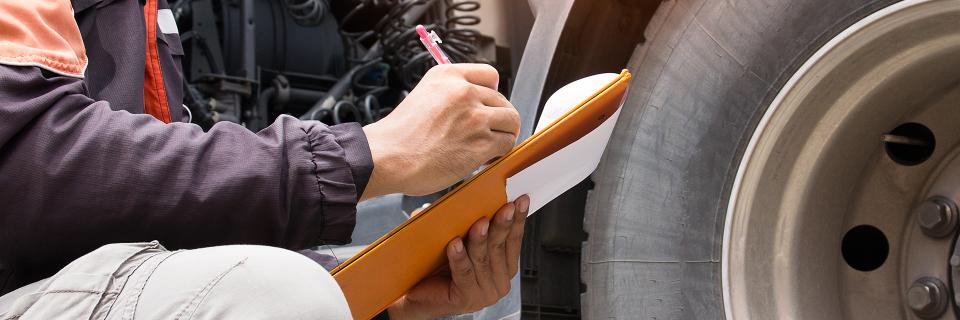
The 2025 International Roadcheck, a North American inspection blitz hosted by the Commercial Vehicle Safety Alliance (CVSA), is set for May 13 - 15.
Established in 1988, the initiative is designed to showcase the commitment to safety held by inspectors, commercial drivers and carriers alike via a 72-hour, high-velocity, high-visibility inspection cycle. The annual event has resulted in nearly two million roadside inspections since its start, good for an average of nearly 15 vehicles inspected per minute across the U.S., Mexico and Canada.
These inspections help ensure the safety of pedestrians, drivers and shipments by checking for vehicle maintenance and driver compliance practices. The goal is to weed out which vehicles and drivers aren’t fit to be on the road in order to prevent potential accidents and other problems. Below, we’ll go over what drivers can expect during the inspection process and talk about areas of focus for the 2025 inspection blitz.
CSVA Inspections: The Basics
Inspections can be held at weigh stations, border checkpoints, bus terminals, carrier terminals or during any roadside traffic stop. During the inspection blitz, the CVSA is watching for four main violation categories:
- Driver violations
- Out-of-service drivers
- Vehicle defects
- Out-of-service vehicles
There are eight levels of inspection, but during the International Roadcheck, inspectors commonly focus on Levels One and Two.
Level One: North American Standard Inspection
The Level One inspection is a 37-step overview of both the driver and the vehicle, including paperwork (licensure, inspection reports, hours of service, etc.), alcohol and drug use, brake systems, lighting, steering and more.
Level Two: Walk-Around Driver/Vehicle Inspection
The Level Two inspection is a 31-step review including most of the Level One items but does not require the inspector to get underneath the vehicle.
How to Prepare for CVSA Inspections
If you’re worried about yourself or your fleet during the upcoming inspection blitz, there are a few things you can do to prepare.
- Perform pre-trip inspections before every trip, and be sure to check:
- Brakes and axles
- Tractor protection system
- Brake system warning devices
- Air loss rate
- Steering wheel lash
- Fifth wheel movement
- Make sure you have all the required tools on board and that they’re in working order. Missing or broken fire extinguishers account for a large number of violations each year, so every item counts!
- Audit your paperwork before each trip to ensure you have all the required documentation and that it is legible. Documents can include:
- Permits (if applicable)
- Periodic inspection report
- Daily vehicle inspection report (if applicable)
- Record of duty status
Not everyone will receive an inspection, but if you successfully pass a Level One, you’ll receive a CVSA decal sticker to display, which exempts the vehicle from another Level One inspection for three months.
2025 Inspection Focus
False Records of Duty Status
Every year, the CSVA places a special emphasis on a category of violations based on recent trends within the industry. This year, there are two areas of emphasis: false records of duty status, and tires.
The CSVA notes that hours-of-service regulations are in place to limit driving hours and mandate rest breaks to prevent commercial motor vehicle drivers from operating vehicles while fatigued. However, those regulations are only useful when drivers follow them.
In addition to checking your hours-of-service compliance, inspectors will also look for the following:
- Electronic logging device tampering, including driving while not logged in, disconnected devices and improper edits
- Ghost drivers (claiming a co-driver when there is no co-driver present)
- Improper use of the personal conveyance special driving category
- Improper use of other exceptions, including adverse driving conditions
- Recording off-duty time while performing work for a motor carrier or non-motor carrier
The CSVA is hoping that making hours-of-service violations an area of focus will remind motor carriers to accurately reflect their times and duty statuses in their RODS.
Tires
The other primary area of focus for the CSVA this year will be vehicles’ tires. The CSVA notes the importance of proper tire maintenance, and that tire failure in transit is a hazard to everyone on the road.
During the tire inspection portion of the CSVA, the inspector will look for:
- Low tread depth
- Audible air leaks
- Flat tires
- Belt material or casing ply exposed in the tread or sidewall
- Tread or sidewall separation
- Bulges in the sidewall
- Improper repairs, such as rubber-coated plugs in the sidewall
- Items lodged between dual tires
Before inspection week, be sure to have all your tires — including sidewalls, rims, and hubs — checked for cuts and bulges, improper repairs, exposed fabric or cords, cracks or bends and worn or missing parts.